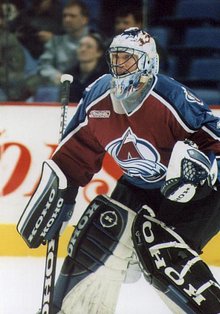Goaltender
|
|
See also: Goalkeeper

The goaltender, goalie, (or netminder in British English) in ice hockey is a player who defends the goal net from shots. He plays in the area in front of the net called the goal crease. Due to the power and frequency of shots, the goaltender wears special equipment designed to protect the body from direct impact.
The goaltender has special privileges that other players do not. His equipment is not subject to the same regulations. He may legally hold the puck with his hands to cause a stoppage of play. If a player from the other team hits him without making an attempt to get out of his way, the offending player is penalized.
Goaltending equipment
Most modern goaltending equipment is made from the same basic materials: hydrophobic synthetic leather and nylon on the outside; dense closed-cell foams and plastics inside.
The National Hockey League and most other leagues specify maximum dimensions of goaltending equipment to prevent goalies from having an unfair advantage[1] (http://nhl.com/hockeyu/rulebook/rule21.html).
Blocker
The blocker is worn on the hand that holds the stick. It consists of a glove with a rectangular board attached to the backhand side.
Chest and arm protector
The chest and arm protector (often referred to as the C/A) is designed to protect the chest and arms from the impact of pucks. It is worn under the hockey jersey.
Cup
A goalie cup, which protects the pelvic area, is more protective than a common jockstrap. In addition, the cup is padded to spread an impact over a larger area.
Instead of a cup , female goalies wear a pelvic protector called a jill.
Leg pads
Goalies wear special leg pads that descend from cricket pads. The pads are typically 10 to 12 inches (25–30 cm) wide and extend 4 to 8 inches (10–20 cm) above the knee.
Mask
The first commonly used goalie masks were solid fiberglass with holes for the eyes, nose, mouth, and for ventilation. Today, most goalies don masks made of fiberglass, kevlar, carbon fiber, and other composite materials. Modern masks have a large cutout in the eye and nose area covered by a steel or titanium cage.
An alternative to the mask is the helmet and cage combo, which consists of a wire facemask attached to a standard hockey helmet.
Pants
Goalies' protective short pants are similar to the pants forwards and defensemen wear. They have heavy padding in the thigh area with lighter padding in the back and sides covering the back of the thighs, tailbone, buttocks, and waist.
Skates
Goal skates differ from regular hockey skates. The blade is longer, wider, and flatter to provide the goalie with more stability. It is made out of carbon steel rather than stainless steel. The blade is shorter vertically so that the goaltender is lower to the ice. The boot does not have a tendon guard, which is the piece of a regular hockey skate that extends up the back of the ankle to protect the Achilles' tendon. Finally, the boot is inside a plasic cowling to protect the foot from direct impact.
Stick
The special hockey stick goaltenders use has a blade that is approximately 3½ inches (8.9 cm) wide. The lower 25 to 28 inches (63.5–71 cm) of the shaft is widened to provide more blocking surface. This area is called the paddle. Although traditional goalie sticks were usually made completely of wood, most modern sticks are reinforced with graphite and fiberglass and the paddle and blade are injected with foam to make them lighter. Recently, manufacturers have begun to produce sticks made completely from composite materials, which are more durable.
Trapper
The trapper, catcher, or catch glove is the glove worn on the free hand. It is similar to a baseball mitt, but it is much more protective and has a deeper pocket.
The Vezina Trophy is awarded each year by the NHL to the leagues most outstanding goaltender.
See Also
